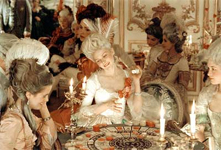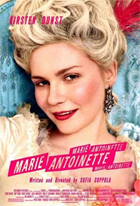Marie Antoinette
|  During the opening credits for Marie Antoinette, which otherwise appear over a black background, writer/director Sofia Coppola inserts a brief tableaux shot of the notorious French queen right before the title card. Marie is lounging in her boudoir, surrounded by pink cakes, with a maid at her feet putting on her shoes. It is the very portrait of pampered decadence, and Marie unexpected turns to the camera and gives a little smile, seeming to suggest a kind of smug indifference, which is precisely how she was portrayed by the rebelling mobs of the French Revolution who took off her head as a symbol of the excesses of French royalty at the expense of the people. During the opening credits for Marie Antoinette, which otherwise appear over a black background, writer/director Sofia Coppola inserts a brief tableaux shot of the notorious French queen right before the title card. Marie is lounging in her boudoir, surrounded by pink cakes, with a maid at her feet putting on her shoes. It is the very portrait of pampered decadence, and Marie unexpected turns to the camera and gives a little smile, seeming to suggest a kind of smug indifference, which is precisely how she was portrayed by the rebelling mobs of the French Revolution who took off her head as a symbol of the excesses of French royalty at the expense of the people.Coppola uses this single, effective shot as a set-up, a small act of clever misdirection, because her lavishly mounted film paints an extremely sympathetic portrait of Marie as a misunderstood free spirit trapped in the confines of rigid French royalty. Using Antonia Fraser’s well-regarded 2001 revisionist history Marie Antoinette: The Journey as her source material, Coppola tells Marie’s story as that of a young girl who was ill-advisedly thrust into a position of great power and expectation. Marie Antoinette, who was just 14 when she was forced to discard her entire life in order to marry the heir to the throne of France as part of an Austrian-Franco alliance, is played by Kirsten Dunst, who embodies the character from a giggly teenager to adulthood. The first words she utters in the film are to sob the name “Mops” as her beloved pug is wrenched from her hands at the border, part of the necessary stripping of everything Austrian from her before she steps on French soil. As naïve and silly as she is at this point, her future husband, Louis XVI (Jason Schwartzman, looking soft and impotent), is even more so. More comfortable playing with locks than trying to pick the locks of his new bride, Louis fails to fully consummate their marriage for seven years, not out of lack of desire, but because he literally doesn’t know what to do. Meanwhile, the royal bloodline hangs in the balance and all the blame is put on Marie, specifically in a series of scolding letters from her mother. Such personal indignities are coupled with the rigorous nature of formal protocol at Versailles, which often borders on the truly absurd. When Marie finally says “This is ridiculous” in response to having half the court in her chambers when she awakes, her meticulous chaperone (Judy Davis) quickly replies, “This is Versailles!” Throughout the film, Marie is depicted as a victim of circumstance, and while Coppola does not suggest that she was perfect, her flaws--such as her frivolous overspending and lack of attention to important matters of state--are portrayed as the understandable results of a generally good-natured person being placed into a position for which she is ill-suited. The decadence of her later years is depicted as an inevitability, the result of a woman being unable to get outside a life of constant pampering. She is, more than anything, misunderstood, and even her infamous comment “Let them eat cake” is portrayed as a misquotation. It is not ironic, then, that no film this year has been the subject of more misinformation than Marie Antoinette, which was early on depicted in the press as a radically revisionist history that was roundly booed by audiences when it debuted a Cannes. Yes, there were some boos and catcalls from the balcony at the Lumière Theater when the final credits rolled, but they came from a small minority of French protectionists who were likely to boo at anything about France not made by the French. As for the film’s revisionist tendencies and supposed postmodern mixing of the past and present, Moulin Rouge it is not. While the film does include ’80s-era post-punk pop music by the likes of Gang of Four, New Order, Bow Wow Wow, and Siouxsie and the Banshees on the soundtrack and there is a brief glimpse of a pink Converse high-top (blink and you’ll miss it), the film as a whole plays very close to the conventions of the historical costume drama. Coppola is not interested in jarring you out of the 18th century, but rather forging connections between then and now. Her use of pop music is actually one of her most effective gambits, and it gives several scenes a needed dose of energy, vitality, and relevance they might otherwise have lacked. The connection of Marie Antoinette to modern celebrity culture is inescapable, especially in the way vicious gossip both feeds the royalty and is its undoing. Versailles of the late 18th century is portrayed as a universe in a bubble from which its inhabitants never need leave, lest they actually come into contact with their subjects (much like Hollywood itself, something Coppola is intimately familiar with having grown up in it as the daughter of a revered director-icon). It is crucial, therefore, that we never see any character who is not either royalty or a servant of royalty until the final moments of the film, when the revolution arrives with flaming torches outside Versailles’ ornate windows. Marie Antoinette is also fascinating in the way it connects thematically with Coppola’s previous works. She has made three features now--The Virgin Suicides (1999), Lost in Translation (2003), and Marie Antoinette--each of which is set in a specific time and place (American suburbia in the 1970s, Tokyo in the present day, and France in the late 1700s, respectively), which gives their thematic semblance an air of universality: No matter how much we change, some things stay the same. While the image of a displaced young woman searching for connection will immediately bring to mind Lost in Translation (2003), it is Coppola’s fascination with perception versus reality that is her work’s true hallmark. In all three of her features, she has given us protagonists who are the victims of others’ perceptions of them, whether it be the mysterious Lisbon sisters of The Virgin Suicides or Bill Murray’s middle-age movie star in Lost in Translation. Like Marie Antoinette, both in her own time and now, Coppola’s characters are the objects of scrutiny, and at some point they literally give up and forge their own existence, which is where they find their true liberation (or demise). The tragedy of Marie Antoinette is that she finds both. Copyright ©2006 James Kendrick Thoughts? E-mail James Kendrick All images copyright ©2006 Columnia Pictures |
Overall Rating: 


 (3.5)
(3.5)


